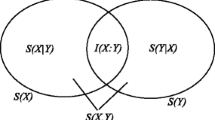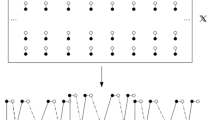Abstract
For the probabilistic description of all the joint von Neumann measurements on a D-dimensional quantum system, we present the specific example of a context-invariant quasi hidden variable (qHV) model, proved in Loubenets (J Math Phys 56:032201, 2015) to exist for each Hilbert space. In this model, a quantum observable X is represented by a variety of random variables satisfying the functional condition required in quantum foundations but, in contrast to a contextual model, each of these random variables equivalently models X under all joint von Neumann measurements, regardless of their contexts. This, in particular, implies the specific local qHV (LqHV) model for an N-qudit state and allows us to derive the new exact upper bound on the maximal violation of 2\(\times \cdots \times \)2-setting Bell-type inequalities of any type (either on correlation functions or on joint probabilities) under N-partite joint von Neumann measurements on an N-qudit state. For d = 2, this new upper bound coincides with the maximal violation by an N-qubit state of the Mermin–Klyshko inequality. Based on our results, we discuss the conceptual and mathematical advantages of context-invariant and local qHV modelling.
Similar content being viewed by others
Notes
In the mathematical physics literature, this probability model is often named after Kolmogorov. However, in the probability theory literature, the term “Kolmogorov model” is mostly used [2] for the Kolmogorov probability axioms [3]. These axioms hold for a measurement of any nature, in particular, quantum, see also our discussion in [4, 5].
Here, \(\Omega \) is a set and \(\mathcal {F}_{\Omega }\) is an algebra of subsets of \(\Omega .\)
For the general framework on Bell-type inequalities, see [18].
In a contextual model, a quantum observable can be also modelled by a variety of random variables but which of these random variables represents an observable \(X\) under a joint von Neumann measurement depends specifically on a context of this joint measurement, i. e. on other compatible quantum observables measured jointly with \(X\).
This notation means [18] that two observables are measured at each of \( N \) sites.
On this notion, see, for example, Sect. 3 in [19].
References
Von Neumann, J.: Mathematical Foundations of Quantum Mechanics. Princeton University Press, Princeton, NJ (1955)
Shiryaev, A.N.: Probability. Springer, Berlin (1996)
Kolmogorov, A.N.: Grundbegriffe der Wahrscheinlichkeitsrechnung. Springer, Berlin (1933)
Khrennikov, A.Y., Loubenets, E.R.: On relations between probabilities under quantum and classical measurements. Found. Phys. 34(4), 689–704 (2004)
Loubenets, E.R.: Nonsignaling as the consistency condition for local quasi-classical probability modeling of a general multipartite correlation scenario. J. Phys. A: Math. Theor. 45, 185306 (2012)
Kochen, S., Specker, E.P.: The problem of hidden variables in quantum mechanics. J. Math. Mech. 17(1), 59–87 (1967)
Holevo, A.S.: Statistical Structure of Quantum Theory. Springer, Berlin (2001)
Loubenets, E.R.: Context-invariant quasi hidden variable (qHV) modelling of all joint von Neumann measurements for an arbitrary Hilbert space. J. Math. Phys. 56, 032201 (2015)
Loubenets, E.R.: On the probabilistic description of a multipartite correlation scenario with arbitrary numbers of settings and outcomes per site. J. Phys. A: Math. Theor. 41, 445303 (2008)
Bell, J.S.: On the problem of hidden variables in quantum mechanics. Rev. Mod. Phys. 38(3), 447–452 (1966)
Bell, J.S.: On the Einstein podolsky rosen paradox. Physics 1, 195–200 (1964)
Einstein, A., Podolsky, B., Rosen, N.: Can quantum-mechanical description of physical reality be considered complete? Phys. Rev. 47, 777–780 (1935)
Loubenets, E. R.: Quantum states satisfying classical probability constrains. Banach Center Publ. 73, 325–337 (2006); E-print arXiv:quant-ph/0406139 (2004)
Loubenets, E.R.: “Local Realism”, Bell’s Theorem and Quantum “Locally Realistic” Inequalities. Found. Phys. 35(12), 2051–2072 (2005)
Khrennikov, A.Y.: Bell’s inequality: physics meets probability. arXiv:0709.3909 (2007)
Khrennikov, A.Y.: Bell argument: locality or realism? Time to make the choice. arXiv:1108.0001 (2011)
Werner, R.F.: Quantum states with Einstein-Podolsky-Rosen correlations admitting a hidden-variable model. Phys. Rev. A 40, 4277–4281 (1989)
Loubenets, E.R.: Multipartite Bell-type inequalities for arbitrary numbers of settings and outcomes per site. J. Phys. A: Math. Theor. 41, 445304 (2008)
Loubenets, E.R.: Local quasi hidden variable modelling and violations of Bell-type inequalities by a multipartite quantum state. J. Math. Phys. 53, 022201 (2012)
Man’ko, O.V., Man’ko, V.I.: Quantum State in probability representation and tomography. J. Russ. Laser Res. 18, 407–444 (1997)
Man’ko, V.I., Man’ko, O.V.: Spin state tomography. J. Exp. Theor. Phys. 85, 430–434 (1997)
Fine, A.: Hidden variables, joint probability, and the Bell inequalities. Phys. Rev. Lett. 48, 291–294 (1982)
Tsirelson, B.S.: Quantum generalizations of Bell’s inequality. Lett. Math. Phys. 4, 93–100 (1980)
Werner, R.F., Wolf, M.M.: All multipartite Bell correlation inequalities for two dichotomic observables per site. Phys. Rev. A 64, 032112 (2001)
Acknowledgments
I am very grateful to Professor A. Khrennikov for valuable discussions.
Author information
Authors and Affiliations
Corresponding author
Appendix
Appendix
Let us first consider the bipartite case \(N=2.\) For simplicity of notations, denote by \(X_{i}\), \(i=1,2,\) observables measured by Alice and by \(Y_{k},\) \( k=1,2\), measured by Bob. For this case, the values of the real-valued distribution \(\nu _{2\times 2}^{(\rho _{d,2})}(\cdot |X_{1},X_{2},Y_{1},Y_{2}),\) standing in (15), are defined as
where (i) the notation \(Z^{(\pm )}\) means the positive operators, decomposing a self-adjoint operator \(Z=Z^{(+)}-Z^{(-)}\) and satisfying the relation \(Z^{(+)}Z^{(-)}=Z^{(-)}Z^{(+)}=0\), (ii) the probability distributions \(\alpha _{X_{i}}^{(\pm )}(\cdot |y_{1},y_{2}),\) \(i=1,2,\) are defined via the relation
From (20) and (21) it follows that, for the distribution \(\nu _{2\times 2}^{(\rho _{d,2})},\) the total variation norm
where \(\left| \{\mathrm {P}_{Y_{1}}(y_{1})\mathrm {P} _{Y_{2}}(y_{2})\}_{\mathrm {sym}}\right| \) is the absolute value operator
Calculating \(\left| \mathbb {\{}\mathrm {P}_{Y_{1}}(y_{1})\mathrm {P} _{Y_{2}}(y_{2})\}_{\mathrm {sym}}\right| ,\) we find
where \(\phi _{Y}^{(k)}, k=1,\ldots ,d,\) are orthonormal eigenvectors of an observable \(Y\) and \(\alpha _{k_{1},k_{2}}=\langle \phi _{Y_{1}}^{(k_{1})}|\phi _{Y_{2}}^{(k_{2})}\rangle \). Substituting (24) into (22) and taking into account that \(\sum \limits _{k_{i}}\left| \alpha _{k_{1},k_{2}}\right| \le \sqrt{d}, i=1,2,\) we finally derive
For \(N>2,\) the real-valued distribution
in (15) is similar by its construction to distribution (20) with the replacement of \(\{ \mathbb {I}_{\mathbb {C}^{d}}\mathbb {\otimes }\frac{1}{2} \{\mathrm {P}_{Y_{1}}(y_{1})\mathrm {P}_{Y_{2}}(y_{2})_{\mathrm {sym} }^{(\pm )}\} \}\) by the \(N\)-partite tensor product of identity operator \( \mathbb {I}_{\mathbb {C}^{d}}\) and \((N-1)\) factors of the form \(\frac{1}{2} \{\mathrm {P}_{X_{n}^{(1)}}(x_{n}^{(1)})\mathrm {P} _{X_{n}^{(2)}}(x_{n}^{(2)})\}_{\mathrm {sym}}^{(\pm )}\) at each \(n\)th of \( (N-1)\) sites. As a result,
Rights and permissions
About this article
Cite this article
Loubenets, E.R. Context-Invariant and Local Quasi Hidden Variable (qHV) Modelling Versus Contextual and Nonlocal HV Modelling. Found Phys 45, 840–850 (2015). https://doi.org/10.1007/s10701-015-9903-8
Received:
Accepted:
Published:
Issue Date:
DOI: https://doi.org/10.1007/s10701-015-9903-8




